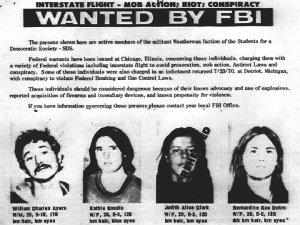In 1974 Weather Underground members Bill Ayers, Bernardine Dohrn, Jeff Jones, and Celia Sojourn, released a new document from the Weather Underground. This document titled “Prairie Fire: The Politics of Revolutionary Anti-Imperialism” took in the new age of a post Vietnam America, began to confront American imperialism from a more Marxist/Leninist approach. The name for the writing was derived from the writings of Mao Zedong, the famed Chinese communist revolutionary. In Mao’s writings, in his “Little Red Book,” he states “a single spark can set a prairie fire,” this being an analogy for revolution. Fallowing the ideology of a Marxist/Leninist and a Mao philosophy “Prairie Fire”, called for a violent overthrow of the United States government, and the installment of a Dictatorship of the Proletariat. The Dictatorship of the Proletariat refers to the Marxist system of government in which the proletariat, or working class, holds the absolute political power. This is a sign that at this point The Weather Underground is dismissing, it’s once primary ideals of a “youth revolution”, and returning to former somewhat S.D.S ideals dealing with a labor driven movement.
Over five thousand copies of “Prairie Fire”, circulated throughout the nation and lead to the creation of multiple Prairie Fire Organizing Committees within several U.S. cities. What essentially happened here is after the failure of “Days of Rage“, to inspire thousands of youth to bring violent revolution to the streets the Weathermen of the time decided to renounce the far “left”, and move underground. This however caused the Weather Underground to lose sight of its commitment to mass struggle. Furthermore this made any attempt of an alliance with a more left mass struggle supporter far more difficult.
In 1974 when “Prairie Fire” was written the Weather Underground had realized the shortcoming of there underground tactics in the previously stated sense. So “Prairie Fire”, called for the creation of both mass and clandestine, or underground, organizations. The clandestine organizations would be in charge of the development and early creation of a people’s militia, as well as carrying out previous underground tactics, and raising consciousness. That mass organization would support and encourage armed action to the mass of the public, in a more legitimized fashion. Under this ideology The Weather Underground could facilitate a far larger mass fallowing, while still advocating for a violent militant revolution. A quote within “Prairie Fire”, states “to leave people unprepared to fight the state is to seriously mislead them about the inevitable nature of what lies ahead.” This quote is in reference to the necessity of militant revolution a later quote states, “never disassociate mass struggle from revolutionary violence to do so was to do the states work”.
“Prairie Fire”, had an unforeseen consequence however. After its release the Weather Underground split into two separate factions. The first was the “Prairie Fire Collective”, who favored a more mass, above ground, revolutionary tactic. Due to the fact that many of the Weather members faced limited to no charges due to illegal F.B.I surveillance, many members, including Bill Ayers and Bernadine Dohrn, came out of hiding to mass the “Prairie Fire Collective”. The other faction that came into being due to the writing was the “May 19th Communist Organization”. Who remained underground, and would later be known for being responsible for the Brinks robbery.

